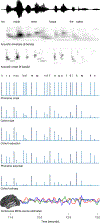Rapid Transformation from Auditory to Linguistic Representations of Continuous Speech
- PMID: 30503620
- PMCID: PMC6339854
- DOI: 10.1016/j.cub.2018.10.042
Rapid Transformation from Auditory to Linguistic Representations of Continuous Speech
Abstract
During speech perception, a central task of the auditory cortex is to analyze complex acoustic patterns to allow detection of the words that encode a linguistic message [1]. It is generally thought that this process includes at least one intermediate, phonetic, level of representations [2-6], localized bilaterally in the superior temporal lobe [7-9]. Phonetic representations reflect a transition from acoustic to linguistic information, classifying acoustic patterns into linguistically meaningful units, which can serve as input to mechanisms that access abstract word representations [10, 11]. While recent research has identified neural signals arising from successful recognition of individual words in continuous speech [12-15], no explicit neurophysiological signal has been found demonstrating the transition from acoustic and/or phonetic to symbolic, lexical representations. Here, we report a response reflecting the incremental integration of phonetic information for word identification, dominantly localized to the left temporal lobe. The short response latency, approximately 114 ms relative to phoneme onset, suggests that phonetic information is used for lexical processing as soon as it becomes available. Responses also tracked word boundaries, confirming previous reports of immediate lexical segmentation [16, 17]. These new results were further investigated using a cocktail-party paradigm [18, 19] in which participants listened to a mix of two talkers, attending to one and ignoring the other. Analysis indicates neural lexical processing of only the attended, but not the unattended, speech stream. Thus, while responses to acoustic features reflect attention through selective amplification of attended speech, responses consistent with a lexical processing model reveal categorically selective processing.
Keywords: cohort entropy; cohort model; magentoencephalography; phoneme surprisal; temporal response function.
Copyright © 2018 Elsevier Ltd. All rights reserved.
Conflict of interest statement
Declaration of Interests
The authors declare no competing interests.
Figures




Comment in
-
Neuroscience: Great Expectations at the Speech-Language Interface.Curr Biol. 2018 Dec 17;28(24):R1396-R1398. doi: 10.1016/j.cub.2018.10.063. Curr Biol. 2018. PMID: 30562533
References
-
- McQueen JM (2007). Eight questions about spoken word recognition. In The Oxford Handbook of Psycholinguistics, Gaskell MG, ed., pp. 37–53.
-
- Phillips C, Pellathy T, Marantz A, Yellin E, Wexler K, Poeppel D, McGinnis M, and Roberts TPL (2000). Auditory Cortex Accesses Phonological Categories: An MEG Mismatch Study. J. Cogn. Neurosci 12, 1038–1055. - PubMed
-
- Stevens KN (2002). Toward a model for lexical access based on acoustic landmarks and distinctive features. J. Acoust. Soc. Am 111, 1872–1891. - PubMed
-
- Marslen-Wilson W, and Warren P (1994). Levels of perceptual representation and process in lexical access: Words, phonemes, and features. Psychol. Rev 101, 653–675. - PubMed
Publication types
MeSH terms
Grants and funding
LinkOut - more resources
Full Text Sources
Other Literature Sources

